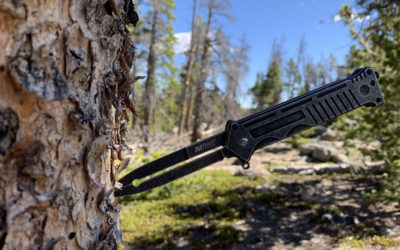If you have researched knives to any degree, you have probably realized that there are a lot of different steels that are used in the production of knives. The different kinds of steels range from softer steel that is very easy to sharpen but have trouble holding an edge, to rock hard steel that hold an edge beautifully but are harder to sharpen.
Deciding on the right steel is important. So is 5160 steel good for knives? Although the 5160 steel itself is a good steal for knives, you won’t find it in many. 5160 steel is primarily used in swords and large knives, such as survival knives. One reason for this is 5160 is a very durable steel that is also very flexible, which is very important for long blades.
Although 5160 steel is primarily used in longer blades such as swords, here’s an example of a knife that uses 5160 steel.
If you’re interested in making your own knife with 5160 steel, check out this slab of 5160 steel on Amazon.
What is 5160 Steel
Alloy Steel 5160, also sold as AISI 5160, is a high carbon and chromium spring steel. It offers users outstanding toughness, a high level of ductility, and excellent fatigue resistance. Alloy Steel 5160 is also in use in the automotive field in a number of different heavy spring applications, especially for leaf springs. It is important to note that Alloy Steel 5160 can be difficult to weld and machine and may require special procedures.
continentalsteel.com
Did you know that 5160 is actually categorized as spring steel?
Spring steel is a name given to a wide range of steels used in the manufacture of springs, prominently in automotive and industrial suspension applications. These steels are generally low-alloy manganese, medium-carbon steel or high-carbon steel with a very high yield strength. This allows objects made of spring steel to return to their original shape despite significant deflection or twisting.
wikipedia.com
Heat Treatment
AISI 5160 alloy steel is generally hardened using oil. This is also why large knife productions do not use this steel. The steel is quenched at 1525°F and tempered at temperatures ranging from 800 and 1300°F.
Forging
Forging of 5160 alloy steel is performed at temperatures between 1149 and 1204°C (2100 and 2200°F).
Applications
AISI 5160 alloy steel is suitable for manufacturing leaf springs used in automotive field.
How Durable is 5160 Steel
5160 steel is a high carbon and chromium alloy (0.6% carbon content, 0.9% chromium content and 1% manganese content).
Additionally, 5160 steel has been widely adopted by sword manufacturers due to its unique properties. It’s especially well-suited to tools that require a high degree of impact resistance and which need to be capable of taking and keeping an edge through extended use, for example, swords and large knives.
How Popular is 5160 Steel
5160 carbon steel is more popular with forgers than anyone else. It is actually a simple spring steel with chromium added for hardness. 5160 steel holds a good edge while remaining durable and flexible. 5160 is primarily used in swords, but can be found in some knives and tomahawks.
5160 Steel vs 1095 Steel
1095 steel is a very popular steel, especially inn combat knives. In fact, 1095 is the steel used in many US Military fighting knives. The 95 in 1095 stands for .95% carbon content in the steel.
Like stated above, 5160 steel is a spring steel. Because of this, it’s very popular in the production of swords, and some survival knives due to it’s flexibility. However, because it is a spring steel, it lacks some edge retention compared to the 1095 steel.
Depending on what knife you’re looking for, less edge retention is better. If you’re looking for a survival knife, you want a knife that has less edge retention. The reason behind this is if you’re caught in a true survival situation, you want a knife that can easily be sharpened using something like a rock, because you might not have a knife sharpener on you. A knife with a stronger edge retention means it will be harder to sharpen.
RELATED: What Makes a Good Survival Knife: How to Choose the Right One
Caring for 5160 Steel
Despite the addition of chromium, 5160 steel is prone to rusting in the same way as other carbon steel. Care must be taken to prevent oxidation of the blade, but this need only take a few minutes each week to achieve.
After each use, be sure to thoroughly wipe the blade clean of any debris, fingerprints, or liquid.
Spend a few minutes every couple of weeks to apply a thin layer of mineral oil. If you are required to store your blade for any length of time, then apply a coating of Vaseline or Rennaissance to the blade to create a physical barrier between the elements and the blade.
Conclusion
In conclusion, 5160 steel is mainly found in swords. Part of the reason why you do not find 5160 in small knives is because of the production process. It’s more expensive for manufactures to make knives with 5160 steel–due to the production process–than other steel, such as 1095.
Here’s a short recap 5160 steel:
- It’s flexible.
- It’s durable.
- It has less of an edge retention compared to 1095 steel.
- It’s a spring steel.
- It’s primarily found in swords or large knives.
If you have enjoyed this article, be sure to share it!





